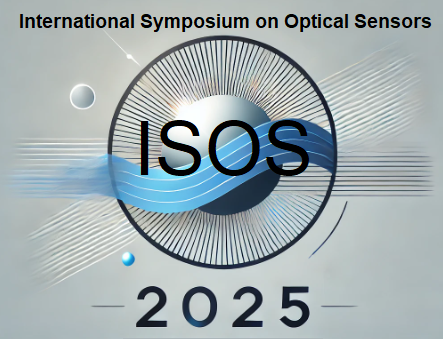International Event on Optical Sensors (ISOS) 2025
IEEE SENSORS COUNCIL OPTICAL SENSORS CLUSTER
On behalf of the Organizing Committee and the Universidad Pública de Navarra (UPNA), we warmly invite you to the International Symposium on Optical Sensors - ISOS 2025. It is a privilege and a pleasure to host for the first time in Pamplona the ISOS symposium, aimed to be annual event for the vibrant optical sensing community. We are working hard to make the event an unforgettable scientific and social experience and our intention is to host a fully in-person event.
The International Symposium on Optical Sensors (ISOS 2025) 2025 continues a series of events that provide a forum aimed to promote scientific exchange and foster close networking and collaborative ties among leading international researchers. This conference has organized thematic symposia covering the frontiers of multidisciplinary research in engineering structure testing, oil and gas well testing, environmental testing, biomedical testing, and process control. This congress features distinguished lecturers, invited speakers as well as oral presentations and poster sessions by leading scientists, experts, and scholars from around the world, at the forefront of the application of optical sensing technologies. It provides an excellent forum to present and discuss works on the emerging challenges offered by technology, in the areas of modeling, design, implementation and test of optical sensors.
The technical program will include regular papers with emphasis on emerging topics including, but not limited to:
Fiber Optic Sensors
Integrated optics Sensors
Optical Chemical sensors and biosensors
Distributed Optical sensors
New concepts in optical sensors
Industrial applications of Optical Sensors
AI combined with optical sensing
Optical sensors networks
Important Dates
- Deadline for submission: March 31st, 2025
- Notification of acceptance: April 15th, 2025
- Registration opens: March 31st, 2025
We will also host a student poster competition that gives students the opportunity to briefly present their research advances and discuss with the conference attendees.
The city of Pamplona, in northern Spain, is the capital of the autonomous region of Navarra. It is a historic destination world famous by writer Ernest Hemingway for its bullrunning festival which takes place every July. It is also the first Spanish city on the French route of the Camino de Santiago pilgrim’s Way. It is a top culinary destination where Michelin-starred chefs share the spotlight with locals preparing traditional “pintxos”. The region owns a privileged nature with must-do day trips: wineries, quaint towns of the Baztan Valley in the shadow of the Pyrenees, explosive colors of the Irati forest at Autumn, cider making, desert caves and the stunning villages along the Camino de Santiago.
Date and Time
Location
Hosts
Registration
- Start time: 01 Jun 2025 06:00 PM
- End time: 03 Jun 2025 06:00 PM
- All times are (UTC+02:00) Madrid
-
 Add Event to Calendar
Add Event to Calendar
- Public University of Navarra
- Campus Arrosadia
- Pamplona, Navarra
- Spain 31006
- Building: Los Olivos
- Room Number: Nicolas García de los Salmones
- Click here for Map
- Contact Event Hosts
- Co-sponsored by Public University of Navarra
Speakers
Jean of UTFPR
Advanced Distributed Optical Fiber Sensing Technologies for Energy Systems
Advanced Distributed Optical Fiber Sensing (DOFS) technologies, particularly Distributed Acoustic Sensing (DAS), offer real-time, high-resolution monitoring for energy systems. DAS enables early anomaly detection, optimizing operational reliability. This paper presents applications that include pipeline integrity assessment, environmental hazard detection, and seismic analysis, enhancing safety and efficiency in the petroleum industry and structural health monitoring.
Biography:
Full Professor at the Federal University of Technology – Paraná (UTFPR), with a Ph.D. in Photonics Engineering. His research focuses on optical fiber sensors, photonic devices, and electromagnetic interference. He has published extensively, holds multiple patents, and has led numerous funded research projects. An active Brazilian Society of Microwaves and Optoelectronics (SBMO) member, he has supervised many doctoral and master's theses. With expertise in electromagnetic theory and wave propagation, he contributes to technological advancements in optical sensing, optoelectronic instrumentation, and applied photonics in engineering.
Email:
Address:UTFPR, , Curitiba, Parana, Brazil
Ignacio of UPNA
Lossy Mode Resonance-Based Sensors with Phase-Matching Layers
Lossy mode resonances are achieved when an absorbing dielectric thin film is deposited onto substrates such as optical fibers or planar waveguides. However, in certain cases, the visibility of the resonance is insufficient to accurately identify the central wavelength, which serves as the basis for monitoring the parameter to be detected. This article discusses recent experimental advancements in incorporating an intermediate thin film between the dielectric thin film and the substrate. This intermediate layer improves the matching between the one or several modes guided in the substrate and the mode guided in the dielectric thin film. This enhancement is crucial for reducing signal noise and thereby improving the limit of detection.
Biography:
Ignacio Del Villar received his MS degree in Electrical and Electronic Engineering and his Ph.D. degree, specialty in Optical Fiber Sensors, in 2002 and 2006, respectively, from the Public University of Navarra (UPNA), where he is a full professor at Electrical, Electronic and Communications Engineering Department. His research interest includes optical fiber sensors and the effect of nanostructured coatings deposited on waveguides, where he has co-authored more than 250 chapter books, journals and conference papers. He is also de cofounder of companies Pyroistech and Eversens.
Email:
Address:UPNA, , Pamplona, Navarra, Spain, 31006
Minghong
Email:
Address:WUHAN UNIVERSITY OF TECHNOLOGY, , Wuhan, Hubei, China
Sanket of BITS PILANI, HYDERABAD CAMPUS
Portable Optofluidic devices for Autonomous and Diversified Sensing Applications: Cyber Physical System Approach
The lecture revolves around the advancement of compact and adaptable sensing instruments that combine fluidics and time-tested optical sensing mechanisms to serve a wide range of bioanalytical sensing applications. By utilizing the benefits of integrated microfluidics, the devices function on a vast array of sensing phenomena, including electrochemistry, colorimetry, chemiluminescence, and electrochemiluminescence. The focus will be on a wide variety of portable devices that can operate independently, allowing for a wide range of detection capabilities to be implemented, including biomarker analysis and environmental pollutant quantification. By implementing a cyber-physical system approach, such devices have experienced substantial enhancements in functionality, flexibility, and autonomy. Furthermore, the interdisciplinary endeavors will illustrate the potential applications of sophisticated and versatile sensing technologies.
Biography:
Sanket Goel did his B.Sc. (Hons.) degree in physics from the Ramjas College, Delhi University, India; MSc (Physics) from IIT Delhi, India; PhD (Electrical and Computer Engineering) from University of Alberta, Canada in 1998, 2000, and 2006 respectively. Subsequently, he did his postdoc at Stanford University (2006-2008), and worked as a PI and Scientist with ASTAR, Singapore (2008- 20011). Earlier, during 2000-2001 he worked with Institute of Plasma Research, (IPR) Gandhinagar, India. On his return to India in 2011, he led the R&D department at the University of Petroleum & Energy Studies (UPES) (2011-2015). Since 2015, he is working with BITS Pilani, India, where currently, he is the Dean and spearheads Research and Innovation related activities. He is also a Professor of Electrical and Electronics Engineering Department at Hyderabad Campus, whereby he headed the Department during 2017-2020. He is the founding principal investigator of a multidisciplinary team of MEMS, Microfluidics and Nanoelectronics (MMNE). His team focusses on developing smart sensors and intelligent energy harvesters to realize turnkey and autonomous devices for diversified applications under several Indian and overseas funded projects. In this context, his team has developed several commercialisable prototypes on printed, wearable, and implantable devices, incorporating novel materials, optimized fabrication processes, smartphone based integrated and cyber-physical systems. Augmenting on various prototypes developed by his team, he has also co-founded 3 companies – Cleome Innovations, Pyrome Innovations and Sensome Innovations, Sanket has won awards, like JSPS Fellowship (2021), BITS Pilani Best Faculty Award (2021), Fulbright fellowship (2015), American Electrochemical Society’s Best students paper award (2005) and University of Alberta PhD thesis award (2005). As of December 2023, Sanket Goel has >350 publications and 32 patents to his credits, has delivered >100 invited talks and guided/guiding 45 PhD students. He has also authored 4 books on Microelectronics & Signal Processing, Miniaturized Electrochemical Devices, 3D printed smart devices and Droplet & Digital Microfluidics. Currently, he is working on writing a compendium book on lab experiments for MEMS course. He is an Associate Editor of several journals like IEEE Sensors Journal, IEEE Transactions on NanoBioscience, Applied Nanoscience, Journal of Nanobiotechnology, Microsystem Technologies, Journal of Micromechanics and Microengineering, Journal of Electrochemical Science and Engineering, and IEEE Access. He is also a Visiting Professor with UiT, The Arctic University of Norway. He is a Fellow, IETE and Fellow, IEI.
Email:
Address:BITS PILANI, , Hyderabad, India
Anna
Pocket-sized optical spectroscopy: revolutionizing food analytics at your fingertips
Optical spectroscopy is transforming food analysis by providing a cost-effective and eco-friendly alternative to traditional methods. With its ability to deliver rapid and non-destructive measurements without the need for harmful chemicals or solvents, it allows green analytics for food quality and safety assessment.
By integrating chemometrics or AI-powered algorithms, optical spectroscopy can decode complex data and perform simultaneous analysis of multiple food components. A single flash of light, combined with advanced spectroscopic training, enables comprehensive quantitative and qualitative assessments of various nutraceutical indicators in one go. It’s an intelligent and sustainable solution for achieving superior food quality and safety standards.
Photonic technologies initially developed for telecommunications, generated an explosion of compact light sources, detectors, micro-spectrometers, spectral sensors, fiber optics, and micro-photonic components. These innovations are now transforming food control, providing compact, robust, and low-cost instruments that are perfect for online applications by users with minimal technical training, as well as by consumers.
In this tutorial, we will show the the latest and most compact optical spectroscopy devices, with a special attention to those operating in the near-infrared, and to pocket-sized and smartphone-connected models. We will show their applications in food analysis and showcase their potential through a live demo.
Get ready to see how these powerful tools can revolutionize food multi-component analyses, and discover opportunities for future collaborations.
Biography:
Anna Grazia Mignani, a physicist by training with a Ph.D. in non-destructive testing, is an Emeritus Researcher at CNR, the National Research Council of Italy, where she has been active since 1984, most recently serving as a Research Director. Her career began with the design and development of fiber optic sensors before expanding into optical spectroscopy-based sensing for environmental and industrial applications.
Her current research focuses on visible and near-infrared spectroscopy for food analysis, particularly in multi-component assessments of nutraceutical and safety indicators using a single light shot and multivariate spectral data processing. Her work has been supported by European and national research grants in applied optical sensing, and she holds multiple US and EU patents.
She has been a visiting scientist at laboratories in Belgium, Ireland, and China and serves as an expert evaluator, project reviewer, and advisor for international funding agencies. A Fellow of SPIE, she was member of the SPIE Board of Directors for the 2016–2018 term. Currently, she is a Member-at-Large of the IEEE Sensors Council, where she previously chaired the Diversity and Inclusion Committee.
From 2017 to 2022, she was seconded to Brussels as a National Expert at the European Research Council Executive Agency of the European Commission, contributing as Scientific Officer to the "Systems and Communication Engineering," "Condensed Matter Physics," and "Synergy" panels.
Email:
Address:IFAC, , Florencia, Toscana, Italy
Agenda
PROGRAM
·
ISOS 2025 Detailed information about the technical sessions can be found by downloading the following PDF file:
https://www.unavarra.es/isos2025


